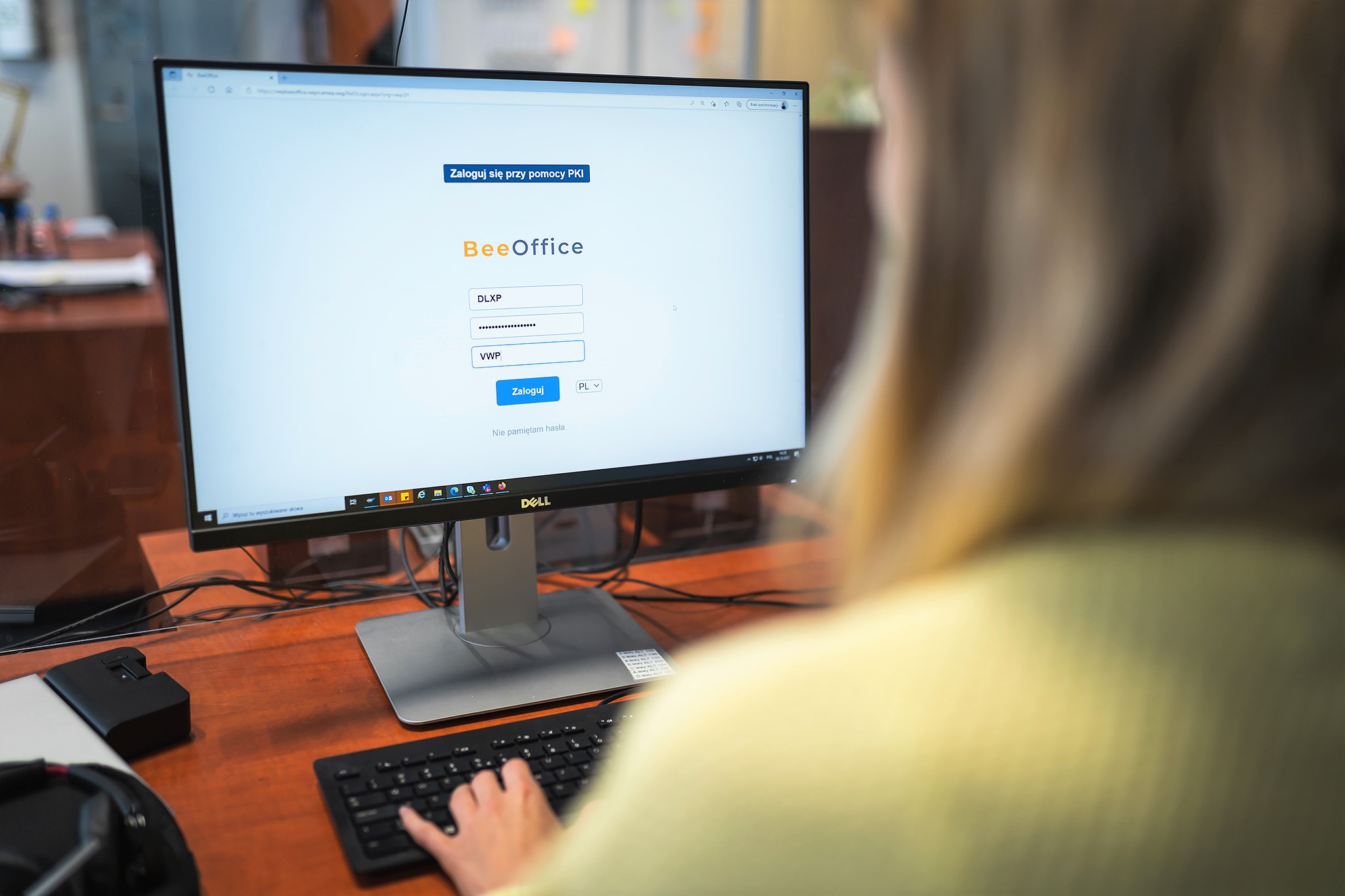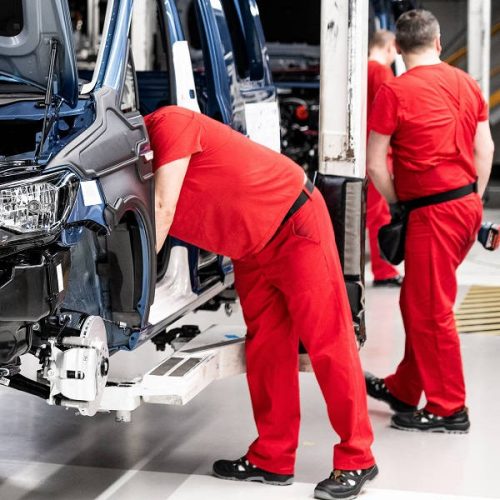Volkswagen Poznań employs almost 10,000 people in four plants (two plants in Poznań, one in Swarzędz and one in Września). The company undertakes many initiatives whose primary goal is to make their work better organized, more comfortable, and their daily interactions with the organization more satisfying. What is important (and not so obvious) – efforts are made to improve the experience of all employees, including production workers.
The HR Department consists of over 100 people. Although HR employees are close to the staff (they have offices in all plants), it is very difficult to maintain a satisfactory level of HR service in the case of such a large team and shift work.
The way to introduce improvements is obvious – far-reaching digitalization and automation of processes, use and integration of bots and other modern technologies and communication channels. The only thing left was to choose the tools to perform these tasks.
Volkswagen Poznań decided to cooperate with All for One Poland and use our ready-made platforms:
BeeOffice and All for One ECM (currently Rockawork).
Since (at the beginning of 2019) the legislator finally allowed for employee documentation to be stored in electronic form (instead of paper), the implementation and management of an e-archive of employee files has become a hot topic. The Employee Personnel Files module allows you not only to meet the requirements of the law, but also to archive other documentation created during the employment relationship, and provides instant and secure access to it.
Efficient and effective communication between the employee and the HR department as well as high quality of internal customer service are one of the important factors in building a positive employee experience. For this purpose, the Service Desk module of the BeeOffice employee self-service portal was used.
One of the important criteria of choosing All for One as a partner in the digitalization of HR processes was our experience in the integration of business systems, in particular the SAP HR system.
In integration with SAP
SAP HR is a central HR system and the primary source of employee data. One of the main objectives of the digitalization of HR processes was to maintain this status quo. That is why it was so important to integrate the implemented solutions with SAP HR.
Both in the BeeOffice Service Desk and in Employee Personnel Files, the list of employees, master data and an organizational structure are downloaded directly from SAP. Both solutions are synchronized with SAP (a connection via WebService is made once a day). In case of detecting a change in the data in the system, the data is updated in All for One applications.
Digital employee records
The possibility of keeping and storing employee files in electronic form introduced by the Regulation of the Minister of Family, Labour and Social Policy on employee records of December 10, 2018 is a real revolution in the work of HR administration teams. Replacing bulky paper folders and binders with easily accessible electronic files makes day-to-day work much easier and saves a lot of money (no need to store archives with documents that are even 50 years old).
Since mid-2021, Volkswagen Poznań has been transferring the paper archive of personnel files to the electronic solution Employee Personnel Files. It is an an add-on to the HR and payroll systems that enables implementation and maintenance of the company’s employee records in digital form. Employee Personnel Files enables HR department employees and line managers to create and view electronic personnel files by assigning electronic documents and scans to appropriate types of documents placed in dedicated parts of electronic personnel files (A,B,C,D parts).
Based on Rockawork, Employee Personnel Files in SAP allows you to configure a uniform electronic model of personnel files, tailored to the needs of a specific organization. The solution offers a uniform structure of personnel files, broken down into folders and types of documents (an HR e-file containing e.g. employment contracts, employment separation certificates, etc.).
The most important features of the solution are:
- Compliance with the guidelines of the ministerial regulation
- Multi-language support
- Suitability for use in multi-branch companies (the possibility of creating roles and a system of authorizations to manage archives in a selected plant)
- Ability to define additional divisions of parts A,B,C,D into subsections and to add new parts
- Readiness to support multiple business units
- Ability to share documentation with employees
- Integration with SAP.
Currently, an e-file is set up and updated digitally. Hiring a new employee in SAP automatically results in the creation of their empty e-file with a ready-made structure (division into sections and subsections). All new documents (scans in PDF format, but also Word files or e-mails) are successively placed in the defined parts and sections of the e-file.
To eliminate paper documentation, some types of documents (e.g. contracts, annexes, certificates) must be signed with a qualified electronic signature.
Digitalization – a big project
The implementation of All for One Employee Personnel Files in integration with SAP allowed for quick “building" of an electronic archive with a ready-made documentation structure and an empty personnel file for each employee. The “only" thing to do was to fill it with documents.
Volkswagen Poznań has been present on the economic map of Poland for almost 30 years. And that’s how long the oldest personnel files of the company have been kept. Given the thousands of employees who have worked at Poznań plants during that time, it is easy (or rather difficult) to imagine the archive space taken up by the files and the costs of storing them.
Therefore, in the project of implementation of All for One Employee Personnel Files at Volkswagen Poznań, the biggest challenge was to develop an effective and possibly fastest method of indexing and entering documents into relevant structures. VWP used the approach developed by All for One Poland.
In practice, the process looks as follows. In the archive room of each of the three plants, a dedicated workstation (a place for safe “unpacking” a paper file, a computer, a scanner, and a barcode label printer) was set up and trained employees were assigned to operate it.
Having a paper document in hand, the employee in the ECM system performs initial indexation: he/she identifies it (by selecting the appropriate section and type of document from the list) and reserves a place for it. Based on this, the system assigns a barcode with the employee’s number, the section designation and the sequence number in the section. Each document is labelled with this code before being scanned. The scanned file is automatically given a name identical to the barcode and on this basis it is automatically paired with the appropriate place in the system and attached as a link.
Before being sent to the archive, documents are directed to a specified folder. There they are electronically signed by an authorized employee and only then sent to the electronic archive.

In order to increase the efficiency and security of the digitalization process, it was decided to divide tasks among several people (one person scans, someone else enters the document into the system, another employee is authorized to use an electronic signature). Scanning quality control was also introduced (to make sure that documents are intelligible and files are not damaged).
In order to maintain the security of sensitive data, as well as to monitor the progress of digitalization of the archive, employees have been provided with tools where they are required to register the status (e.g. a file downloaded from the archive, digitalized).
In total, there are about 16 thousand personnel files in VWP to be digitalized. This process is scheduled to be completed at the end of 2023.
Section E?
The law regulates the type and structure of documents in an employee’s personnel file. However, nothing stands in the way of extending the structure of All for One Employee Personnel Files to include other, optional documents that are created during the employment relationship so that the entire history of interactions with the employee can be collected in one place. Volkswagen Poznań decided to take such a step by archiving payroll documents in the solution.
BeeOffice Service Desk for HR processes
Since June 2021, employee HR requests have been handled in the BeeOffice Service Desk solution. The adopted ticket system (a single request = a ticket in the system) ensures an optimum flow of documents between the VWP employees and the HR Department and within the HR Department itself.
The principle of operation of the solution is simple: each employee’s request is recorded in the solution as a separate ticket. The continuity of the ticket has been ensured. Every action: acceptance of a request, its assignment to HR employees, a response sent to the requester – everything happens within one ticket.
Information about the time of processing and the workflow of a particular request is available. Processed tickets are stored in the system and can be accessed at a later time. The HR Department employees responsible for the processing of requests can use a Scheduler to mark absences. Tickets assigned to a person who is absent on a given day are highlighted. This facilitates their identification and possible assignment to another employee.
The system provides reports on the SLA (Service Level Agreement) response and processing time, i.e. the time to complete the task, determined for each process. Tickets are processed according to the priorities assigned by the requesters.
The possibility of generating collective reports was provided:
- a real-time number of tickets broken down by status, processes, assigned work groups, assigned users,
- a number of tickets in the past broken down by status, processes, assigned work groups, assigned users.
Depending on the position and authorizations, individual employees (or groups of employees) of the Human Resources Department are assigned to process specific types of requests. To ensure high flexibility in defining these authorizations, the BeeOffice filter mechanism was used.

Before the go-live of the solution, consultants from All for One Poland defined templates for the 10 most common types of requests: a nursing break; an application for child custody; reduction of a working time basis; an application for unpaid leave; working time standards; removal of e-ZLA padlocks; checking the leave entitlement; hiring of an employee; appointment of a Master; non-renewal of an employment contract.
VWP employees are gradually expanding this list. The system is planned to ultimately handle approximately 70 HR processes (including changes in working time, a retirement program, absences, the Payer, employee development).
The ticket system can be operated in Polish, English and German.
Different communication methods
The support in the ticket application works well where all employees have access to a computer and are familiar with operating business systems. At VWP, it was necessary to develop other channels of communication and submission of requests, available also to employees on the shop floor.
Currently, all employees can use several methods of submitting HR requests.
- E-mail. The employee sends a message describing their case. They should include their control number (in the subject of the message) and formulate their request as simply and clearly as possible. The message is forwarded to the Service Desk and a ticket is automatically created as a result. The system supports all e-mail addresses, also those outside the VW domain (not all employees have an address in the company domain).
- A dedicated phone number is available for VWP employees. Tone dialling and appropriate scripts guide them through the steps of the process, resulting in the automatic creation of a ticket (integration with the hotline solution).
- Creation of a ticket by the HR Department employee. It is an accepted rule that every employee request – even if made during a traditional visit to the HR department – must be reflected in the form of a service ticket. Sometimes there are also requests from other areas of the HR Department, which are also users of the system.
Distribution of documents to employees
BeeOffice Service Desk is integrated with All for One Employee Personnel Files. A document prepared as a result of the request submission is attached to the employee’s personnel records, and then a direct link to the document in the electronic file is added to the request. This link and the related document are the final product of the request processing, delivered to the employee.
For distributing documents from the e-file to the employees, the mechanism of sending payslips by e-mail already operating at VWP (part of the All for One E-Payslips solution used by VWP) was used. The documents (a PIN-secured ZIP folder) are sent to an e-mail address retrieved from the employee’s master data from the SAP system.
Artificial intelligence in the service of HR
In the process of converting an e-mail from an employee to a ticket in the Service Desk, artificial intelligence solutions were used. The bot “reads" the message, identifies the requester, extracts key words and phrases, and on this basis creates a ticket and assigns it to an appropriate team for processing.
Teaching the RPA (Robotic Process Automation) mechanism to read the intentions of employees and to appropriately distribute tickets is one of the most interesting challenges of this project. The solution is still being developed and tested.
Using AI to automate repetitive business processes is in line with the latest HR trends.
Synergy of solutions
In addition to integration with the SAP HR system, other solutions facilitating communication with employees were used and integrated during the project. RPA is a mechanism providing bots that read employees’ e-mails and automatically create and classify service requests on their basis. A telephone line with hotline software serves the same purpose. Employee documentation and the ticket application were combined and the previously implemented mechanisms for sending emails to employees were used.
Another facilitation for the HR Department employees is the integration of BeeOffice Service Desk and All for One Employee Personnel Files with PKI access cards. This made it possible to provide convenient and yet secure access to the solutions thanks to the Single Sign On mechanism used at VWP – a single login to multiple business applications. All for One Poland has developed for VWP a standard for integrating PKI cards with external systems. It can be more widely used in the future.
Security, comfort, covid
Getting rid of kilometers of archive racks, cost savings on storage, shortening the period of obligatory archiving are the most important benefits of e-files. Furthermore, it is hard to overestimate instant access to documents and the ease of their distribution to employees and among company branches (if an employee is transferred to another plant, their e-file is automatically transferred with them, based on data from SAP). The solution has significantly increased the security level of sensitive data.
Moreover, the service application has improved the quality and comfort of the HR Department’s work. A big gain is the central place of employee service that allows for monitoring the ticket processing time and enables interactions between the employee and the HR department to be archived. Time savings and cost reductions are also real benefits.
In this case, however, the key benefit is the significant improvement in the satisfaction of HR customers, i.e. the company’s employees, who have gained easier and faster access to the HR department, not limited by working hours, and a guarantee of receiving service at the agreed time.
In the current situation, it is also worth noting the advantages of the solution in times of pandemic. Digitalized HR processes are not bound by limitations resulting from difficulties in moving in the plant, sanitation regime or remote working.
Volkswagen Poznań is a manufacturer of Caddy, Transporter, Crafter, MAN delivery vans, including electric vehicles and components. The company was founded in 1993. At present, it has four modern production plants. The headquarters of the company and the factory producing Caddy and Transporter models are located in Antoninek, Poznań. The former Cegielski Factory in the Wilda district of Poznań is one of the largest foundries in Europe. The factory in Września produces a new model of Crafter. The Special Care Body Plant and Suppliers Park are located in Swarzędz. Volkswagen Poznań is the largest car manufacturer in Poland. With almost 10,000 employees, it is the largest employer in Wielkopolska region.



